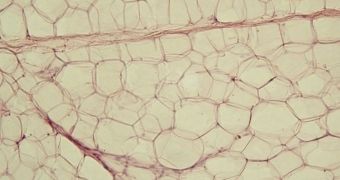A team of experts from the Harvard Medical School and the Dana-Farber Cancer Institute announce the discovery of a new type of cells, which apparently burn calories, rather than store them. The finding could have significant applications in combating obesity and other eating disorders.
The new type of fat cell has thus far only been identified in adults, and researchers who've had a chance to analyze it say that its therapeutic potential is significant. At this type, the cells are called “beige fat.”
HMS and DFCI investigators first identified these cells in very small deposits – about the size of a small pea – which were scattered underneath the skin, especially near and around the collarbone, and alongside the spine. The opposite of beige fat in terms of effects is white fat.
The latter is made up of cells that store calories for later use, and contributes extensively to making people overweight or obese. What researchers hope to do is pit the two types of fat in a fight against each other, on the same batch of available resources, with beneficial results for the patient.
The investigation was led by the HMS/DFCI Sanley J. Korsmeyer professor of cell biology and medicine, Bruce Spiegelman. He was also the senior author of a new paper detailing the findings, which was published in the July 12 online issue of the esteemed scientific journal Cell.
Experts also determined that beige fat is different from brown fat, the tissue that burns calories in order to generate heat, and protect our bodies from cold. Until now, scientists only knew about the “conflict” between white and brown fat, unaware of the role beige fat plays, or even its existence.
Spiegelman was part of the team that first proposed the existence of beige fat, back in 2008. However, at that time, researchers were unable to isolate the cells in the lab. This was finally achieved during the new study.
Earlier in 2012, the expert and his team also reported on the discovery of irisin, a chemical produced by exercises, which plays an important role in converting calorie-storing white fat in calorie-burning brown fat.
His studies are partially supported by grants from the US National Institutes of Health (NIH) and the American Heart Association (AHA).

 14 DAY TRIAL //
14 DAY TRIAL //